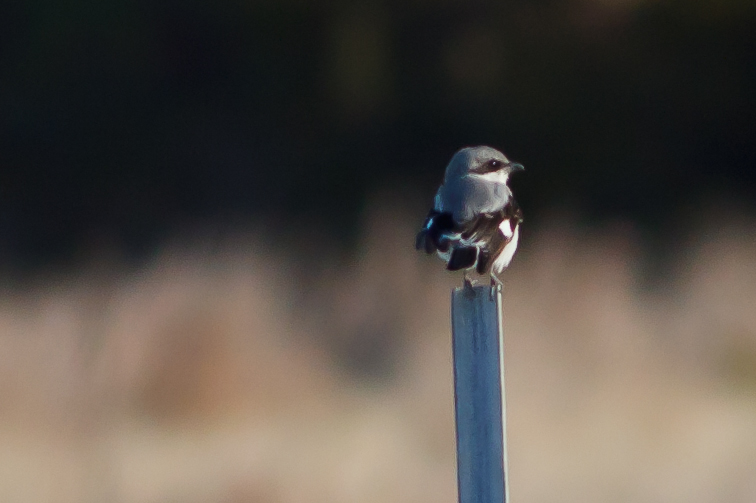Not #516 Northern Loggerhead Shrike
Northern Shrike has been on my target list for a little over a year. It’s not a common bird around New York City, but it does show up regularly in early winter; and when it does it often sticks around one spot for a week or more at a time. However I’ve never before made the effort to chase it, so it doesn’t qualify as a nemesis bird. Nonetheless it was a bit galling when Steve Nanz and the Brooklyn Bird Club found one last week at Jones Beach State Park on a trip I skipped to go to the PDN Photo Expo. Fortunately the bird hung around, probably feeding on Yellow-rumped Warblers and other small birds, and was still near the Theodore Roosevelt Nature Center yesterday where Peter Dorosh, Mary Jo Eyster and myself relocated it yesterday:

We also tried for the Western Kingbird and Common Ground Dove that have been at the eastern end of the island at Captree State Park all week. However we whiffed on those, even though both birds were seen by other people at various times throughout the day. Still I’ve seen both of those in California, so just a minor loss for my state list. Overall, it was a very good day. Our total species count was around 56:
- Brant
- Canada Goose
- Mute Swan
- American Black Duck
- Surf Scoter
- Black Scoter
- Red-breasted Merganser
- Common Loon
- Northern Gannet
- Double-crested Cormorant
- Great Blue Heron
- Northern Harrier
- Sharp-shinned Hawk
- Cooper’s Hawk
- American Kestrel
- Peregrine Falcon
- Black-bellied Plover
- American Oystercatcher
- Greater Yellowlegs
- Marbled Godwit
- Sanderling
- Dunlin
- Laughing Gull
- Ring-billed Gull
- Herring Gull
- Great Black-backed Gull
- Royal Tern
- Rock Pigeon
- Mourning Dove
- Northern Flicker
- Eastern Phoebe
- Northern Shrike
- American Crow
- Horned Lark
- Tree Swallow
- Golden-crowned Kinglet
- Hermit Thrush
- American Robin
- Gray Catbird
- Northern Mockingbird
- European Starling
- Yellow-rumped Warbler
- Chipping Sparrow
- Lark Sparrow
- Savannah Sparrow
- Song Sparrow
- Swamp Sparrow
- White-throated Sparrow
- White-crowned Sparrow
- Dark-eyed Junco
- Northern Cardinal
- Boat-tailed Grackle
- House Finch
- American Goldfinch
- House Sparrow
There was also an American Bittern I missed.
The Shrike was the only life bird, but I did get two new birds for Suffolk County (Boat-tailed Grackle and Peregrine Falcon) and 12 new species for Nassau County. That moves Nassau up to sixth place on my county list, just ahead of Orleans Parish. Orange County, California, is still comfortably in front with 242 species.
- Orange, California 242
- Kings, New York 200
- Queens, New York 192
- Santa Clara, California
- Suffolk, New York 124
- Nassau, New York 115
- Orleans, Louisiana 114
- Monmouth, New Jersey 109
- New York, New York 103
- Richmond, New York 101
- Los Angeles, California 95
- Westchester, New York 83
- Hudson, New Jersey 68
- Somerset, New Jersey 68
- Imperial, California 68
- Bergen, New Jersey 67
- Passaic, New Jersey 66
- San Francisco, California 65
- San Diego, California 63
- Jefferson, Louisiana 58
- Sussex, New Jersey 57
- Washington, Maine 53
- San Bernardino, California 53
- Penobscot, Maine 51
- San Mateo, California 50
- Rockland, New York 49
- Riverside, California 48
- Bronx, New York 42
- Kern, California 37
- Santa Cruz, California 37
- Cook, Illinois 36
- Morris, New Jersey 33
- Hancock, Maine 32
- Middlesex, New Jersey 31
- St. Tammany, Louisiana 26
- Ocean, New Jersey 23
- Orange, New York 18
- Alameda, California 17
- Hunterdon, New Jersey 4
Update:
There seems to be a developing consensus that this individual is not a Northern Shrike after all, but the much rarer (in New York, at least) Loggerhead Shrike. According to David Sibley, “The pale tips on some greater coverts are a sure sign of immaturity – adults of both species have uniform glossy black wings. Therefore the extensive and solid black mask makes it a Loggerhead, since all immature Northerns have narrow and incomplete masks and the only Northerns with a mask approaching this are adults.”
Loggerhead Shrike is not especially rare in California, and when I lived in Irvine I could usually find a Loggerhead on a not especially long bike ride, so I have to take this one back, and Nassau and Orleans are now tied. I think this now officially qualifies Northern Shrike as my new Nemesis Bird.
